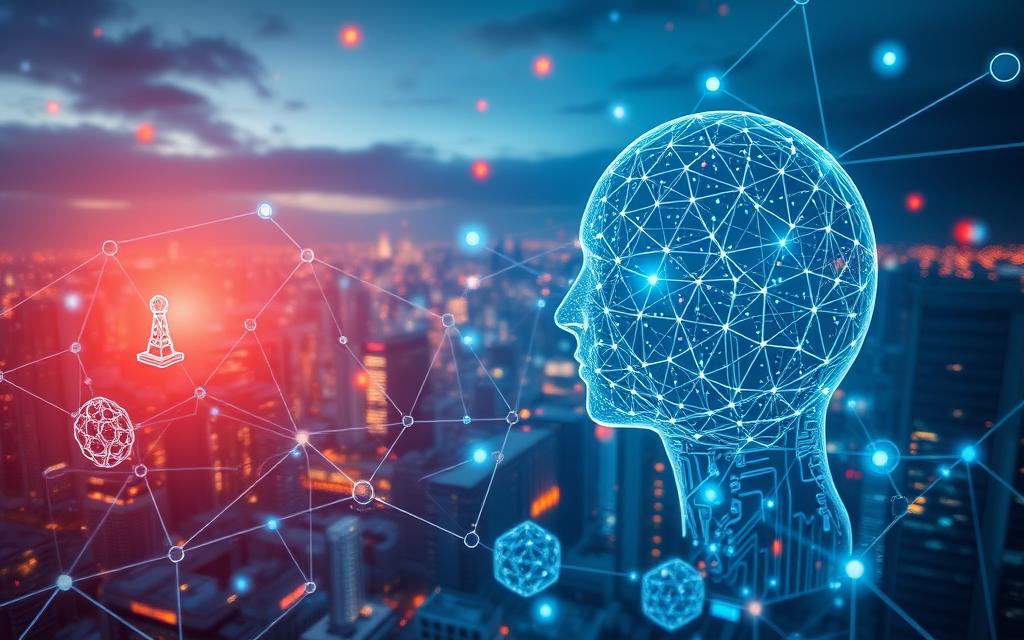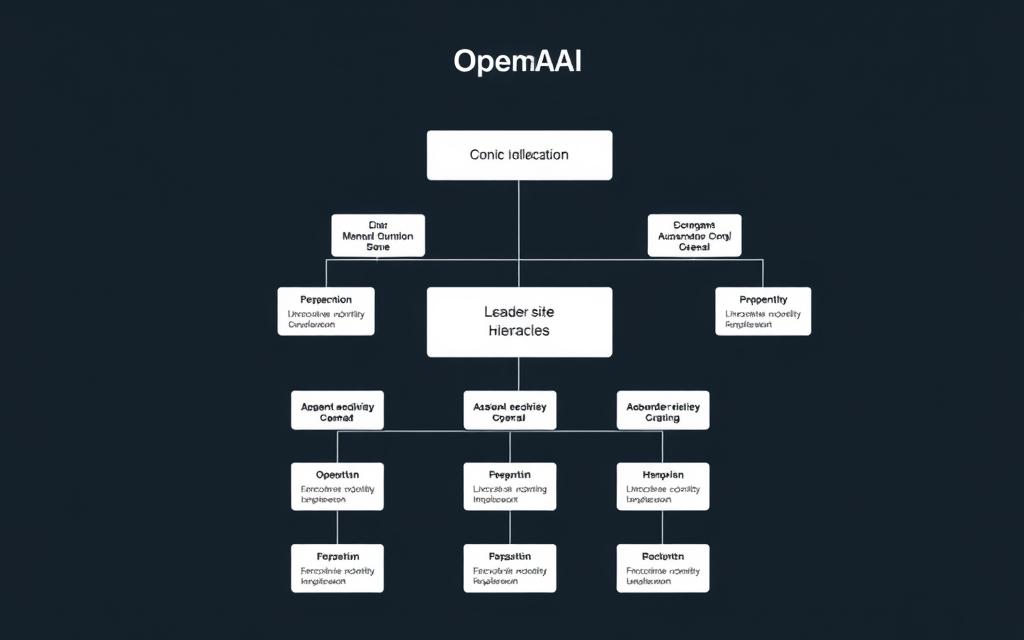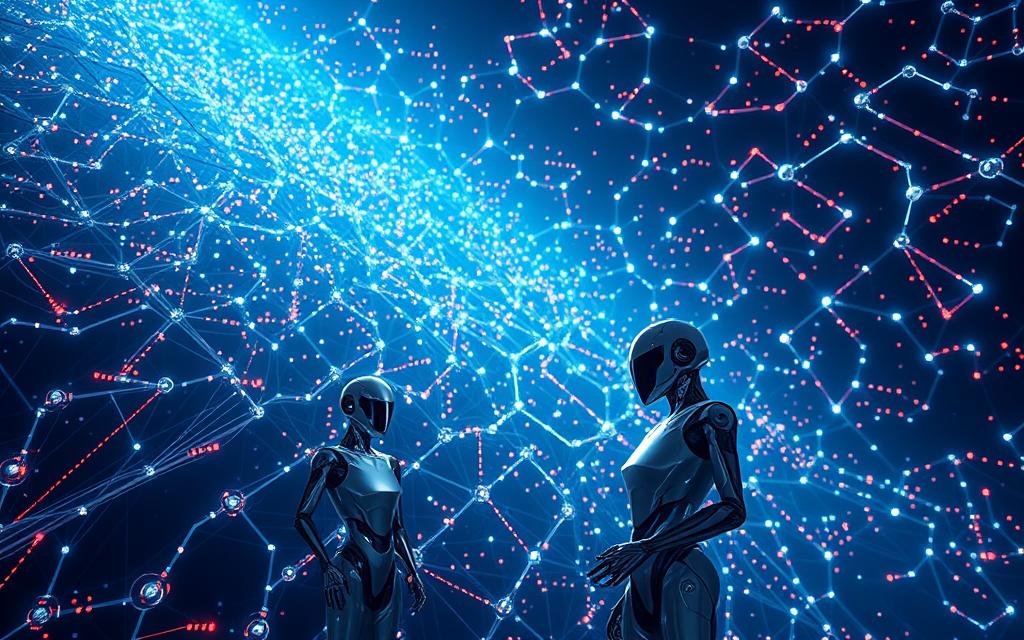Table of Contents
The recent success of ChatGPT has catapulted OpenAI into the spotlight, marking a significant shift in the organization’s trajectory. From its origins as a research-focused entity, OpenAI has evolved into a major commercial player in the artificial intelligence industry.
ChatGPT’s groundbreaking success has not only generated widespread interest in generative AI models but also set the stage for OpenAI’s subsequent developments. As the organization continues to push the boundaries of intelligence and research, its mission to develop “safe and beneficial” artificial general intelligence remains at the forefront.
With its sights set on the future, OpenAI is poised to make significant strides in the competitive AI landscape. As we explore OpenAI’s strategic moves, it becomes clear that these developments will have a profound impact on the future of AI technology.
The Evolution of OpenAI: From Research Lab to AI Powerhouse
OpenAI’s journey from a research lab to an AI powerhouse is a story of innovation and vision. Founded in December 2015 by a group of tech luminaries including Sam Altman, Elon Musk, and others, OpenAI aimed to develop “safe and beneficial” artificial general intelligence (AGI).
OpenAI’s Founding Vision and Early Years
OpenAI was established with the mission to develop highly autonomous systems that outperform humans at most economically valuable work. The founding members shared concerns about AI safety and existential risk, driving the organization’s early commitment to “freely collaborate” with other institutions by making patents and research open to the public.
The initial funding structure of OpenAI included a pledged $1 billion in capital from various investors, although the actual amount collected was $130 million until 2019. This funding supported OpenAI’s early research focus, which established its reputation in the AI community.
| Year | Event | Funding |
|---|---|---|
| 2015 | OpenAI Founded | $1 billion pledged |
| 2019 | Actual funding collected | $130 million |
OpenAI’s early years were marked by significant advancements in AI models and intelligence. The organization’s commitment to developing “safe and beneficial” AGI has driven its technology review processes, ensuring that its innovations benefit humanity broadly.
As OpenAI continues to evolve, its focus on research and development remains unwavering. The organization’s journey is a testament to the power of collaboration and innovation in shaping the future of AI.
The Transition from Non-Profit to “Capped” For-Profit
OpenAI’s transition in 2019 from a non-profit organization to a ‘capped’ for-profit entity marked a pivotal moment in its history. This change was significant as it allowed OpenAI to attract substantial investment from venture funds and offer employees equity stakes in the company.
The ‘capped’ for-profit model means that OpenAI Global, LLC’s profits are capped at 100 times any investment. This structure enables the company to balance its original mission with the need for financial resources to compete with tech giants like Google Brain, DeepMind, and Facebook. The transition was crucial for OpenAI to retain top talent, as many researchers are drawn to organizations that offer stock options.
The creation of OpenAI Global, LLC allowed the company to grant employees equity stakes while maintaining alignment with its original mission. However, this transition also raised concerns about the potential contradiction with OpenAI’s initial commitment to “democratizing” AI. Critics argue that the shift towards a for-profit model could alter the company’s focus and priorities.
To understand the implications of this transition, it’s essential to examine the complex relationship between the non-profit OpenAI, Inc. (the sole controlling shareholder) and the for-profit OpenAI Global, LLC. This relationship is crucial in maintaining the balance between profit-making and the original mission of OpenAI.
| Aspect | Non-Profit Model | Capped For-Profit Model |
|---|---|---|
| Investment Attraction | Limited by non-profit status | Enabled by ‘capped’ for-profit structure |
| Talent Acquisition | Difficult to compete with for-profit tech giants | Able to offer stock options and equity stakes |
| Mission Alignment | Strictly aligned with original mission | Balanced between profit and original mission |
The transition has enabled OpenAI to advance its research and development of new models, providing more information and resources to the public. By creating new content and improving existing models, OpenAI continues to push the boundaries of AI technology.
ChatGPT’s Revolutionary Impact on AI Adoption

OpenAI’s ChatGPT became an overnight sensation, transforming AI adoption. The release of ChatGPT was a major event in the AI boom. By January 2023, it had become the fastest-growing consumer software application in history, gaining over 100 million users in just two months.
Unprecedented Growth
The launch of ChatGPT’s free preview in December 2022 received widespread media coverage, with over a million signups within the first five days. This rapid adoption was a testament to the public’s interest in AI capabilities and the potential for machine learning to transform everyday scenarios.
ChatGPT’s natural language processing abilities demonstrated the practical applications of AI, making it accessible to a broad audience. The chatbot’s ability to understand and generate human-like text revolutionized the way people interact with machines, setting a new standard for intelligence in consumer applications.
Catalyzing Generative AI Interest
ChatGPT catalyzed widespread interest in generative AI, bringing it into the mainstream consciousness. The competitive response from tech giants, including Google’s announcement of Bard, underscored the significance of ChatGPT’s impact. This new era of AI competition sparked innovation across industries, as companies began to explore the potential of generation and features offered by advanced AI models.
The success of ChatGPT created new expectations for human-computer interaction, driving investment in the AI sector and creating what many termed an “AI boom” or “AI race.” As a result, the entire AI landscape began to shift, with companies competing to develop more sophisticated models and improve access to AI technology.
ChatGPT’s influence extended beyond the tech industry, as its features and capabilities raised public awareness of AI’s potential. The chatbot’s ability to process and generate human-like language made it a valuable tool for various applications, further accelerating AI adoption.
OpenAI’s Current Model Lineup
OpenAI continues to push the boundaries of artificial intelligence with its diverse range of models. The company’s commitment to advancing AI research is evident in its expanding lineup of models, each designed to tackle specific tasks and applications.
GPT Family: Advancements and Capabilities
The GPT family, including versions from GPT-3.5 to GPT-4.1, represents a significant advancement in natural language processing. These models have demonstrated remarkable capabilities in generating coherent and contextually relevant text. For instance, the latest models have shown improved performance in understanding nuanced language and responding appropriately.
Key Features of the GPT Family:
- Advanced language understanding and generation
- Improved contextual relevance
- Enhanced capabilities for complex tasks
The “o” Series: Innovations in AI
OpenAI’s “o” series, including o1, o3, and o4-mini, introduces new innovations in AI model development. These models are designed to offer specialized capabilities, potentially enhancing performance in specific areas. The “o” series demonstrates OpenAI’s ongoing research into optimizing model performance and efficiency.
The “o” series models are expected to provide:
- Enhanced performance in specific tasks
- Improved efficiency
- Potential for new applications
Specialized Models: DALL-E, Sora, and Operator
OpenAI has also developed specialized models that extend beyond text generation. DALL-E, introduced in 2021, is a deep learning model capable of generating complex digital images from textual descriptions. It utilizes a variant of the GPT-3 architecture, showcasing the versatility of OpenAI’s research. For more information on how AI models like ChatGPT are evolving, you can visit this page to understand the broader context of AI development.
Sora, a text-to-video model, was unveiled by OpenAI in February. Currently available to red teams for managing risks, Sora represents a groundbreaking advancement in video generation technology. Its potential applications are vast, ranging from creative industries to educational content.
Operator, released on January 23, is an AI agent and web automation tool designed to access websites and execute user-defined goals. Available initially to Pro users in the United States, Operator demonstrates OpenAI’s efforts to expand its AI capabilities into practical, real-world applications.
These specialized models highlight OpenAI’s strategy to develop a comprehensive AI ecosystem that spans multiple modalities, including image, text, and video processing. By advancing research in these areas, OpenAI is poised to drive significant innovation across various industries.
Microsoft’s $13 Billion Investment: Reshaping the AI Landscape
The strategic partnership between OpenAI and Microsoft, backed by a $13 billion investment, is reshaping the future of AI. This collaboration is not just a financial investment; it’s a comprehensive alliance that brings together OpenAI’s cutting-edge AI models and Microsoft’s robust cloud infrastructure.
The Strategic Partnership
The partnership between OpenAI and Microsoft is multifaceted, involving not just financial backing but also technological integration and mutual support. This alliance has enabled OpenAI to scale its operations and enhance its AI models, while Microsoft benefits from the integration of OpenAI’s advanced AI capabilities into its products and services.
Key aspects of the partnership include:
- Integration of OpenAI’s models into Microsoft’s products
- Collaboration on AI research and development
- Mutual support in promoting each other’s services
Azure OpenAI Service: Enterprise-Grade AI Deployment
Azure OpenAI Service is a critical component of the partnership, offering enterprise-grade deployment of OpenAI’s powerful language models. This service provides REST API access to OpenAI’s full model lineup, including the latest o-series and GPT models, with various SDKs for different programming languages.
Azure OpenAI offers several key features that make it attractive to enterprises:
- Security and Compliance: Enterprise-grade security capabilities, private networking, and regional availability ensure that businesses can deploy AI solutions securely.
- Responsible AI: Azure OpenAI includes content filtering and other safety measures to ensure responsible AI use.
- Ease of Use: Businesses can get started with Azure OpenAI by creating resources in their Azure subscription and deploying models.
To illustrate the capabilities of Azure OpenAI, consider the following:
Azure OpenAI provides REST API access to OpenAI’s powerful language models, including o4-mini, o3, gpt-4.1, o3-mini, o1, o1-mini, GPT-4o, GPT-4o mini, GPT-4 Turbo with Vision, GPT-4, GPT-3.5-Turbo, and Embeddings model series. These models can be adapted to specific tasks such as content generation, summarization, image understanding, semantic search, and natural language to code translation.
By leveraging Azure OpenAI, businesses can benefit from:
- Enhanced security and compliance features
- Scalability and flexibility in AI deployment
- Access to the latest AI models and technologies
In conclusion, the partnership between OpenAI and Microsoft, facilitated by Azure OpenAI Service, is transforming the AI landscape by providing enterprises with powerful, secure, and scalable AI solutions.
OpenAI’s Corporate Structure and Leadership

OpenAI’s journey has been marked by significant leadership changes, impacting its direction and strategy. The company has faced challenges in balancing commercial growth with responsible AI development.
The Complex Relationship Between Non-Profit and For-Profit Entities
OpenAI operates with a unique dual structure, comprising both non-profit and “capped” for-profit entities. This complex relationship allows the company to pursue commercial interests while maintaining a commitment to its original non-profit mission.
The non-profit arm focuses on AI research and ensuring that the technology is developed in a responsible manner. Meanwhile, the for-profit entity enables OpenAI to generate revenue through its AI services, including the popular ChatGPT model.
Leadership Changes and Their Impact on Company Direction
In November 2023, OpenAI’s board removed Sam Altman as CEO, citing a lack of confidence in him. However, he was reinstated just five days later following a reconstruction of the board. This dramatic episode highlighted the internal tensions within the company.
Throughout 2024, roughly half of the AI safety researchers left OpenAI, citing concerns about the company’s direction and its role in the industry-wide problem of ensuring AI safety. Key executive departures included Chief Scientist Ilya Sutskever, co-leader Jan Leike, cofounder John Schulman, and CTO Mira Murati.
These leadership changes reflect the ongoing debate within OpenAI about balancing rapid commercial advancement with responsible AI development. The departures of key personnel to rival companies like Anthropic have also reshaped the AI safety landscape.
OpenAI offers a range of AI models and services, including the GPT series and specialized models like DALL-E. The company’s technology review processes are crucial in ensuring the safe and effective deployment of these models.
The company’s commitment to intelligence and research is evident in its continuous advancements in AI capabilities.
Technical Advancements in OpenAI’s Latest Models
Recent advancements in OpenAI’s models have led to breakthroughs in multimodal processing and reasoning capabilities, significantly enhancing their ability to handle complex tasks. These improvements are pivotal in pushing the boundaries of what AI can achieve.
Multimodal Capabilities: Text, Image, and Video Processing
OpenAI’s latest models, such as GPT-4o and GPT-4 Turbo with Vision, have made substantial strides in multimodal processing. They can now handle a combination of text, image, and video inputs, enabling more sophisticated applications. The use of image tokenization allows these models to process visual information by breaking down images into tokens based on their detail level and dimensions.
The number of tokens consumed by image inputs is calculated based on two main factors: the level of image detail (low or high) and the image’s dimensions. This approach enables more efficient processing of visual data, making it possible to integrate images and text seamlessly.
Reasoning and Problem-Solving Improvements
The o-series models from OpenAI have demonstrated significant enhancements in logical reasoning and mathematical problem-solving. These improvements are attributed to advances in training methodologies, architectural changes, and fine-tuning techniques. Benchmark results show that these models perform exceptionally well on standardized tests, programming challenges, and complex reasoning tasks.
The real-world implications of these improvements are vast, enabling more sophisticated applications in fields like scientific research, education, and business analytics. Enhanced reasoning capabilities allow for better decision-making and more accurate predictions, driving innovation across various industries.
The Business of Open AI: Revenue Models and Growth
OpenAI is adopting a comprehensive strategy for its financial growth, focusing on diverse revenue streams and developer-centric offerings. This approach is crucial for sustaining its position in the competitive AI landscape.
Subscription Services: ChatGPT Plus, Team, and Enterprise
OpenAI offers various subscription plans, including ChatGPT Plus, Team, and Enterprise, catering to different user needs. These plans provide additional features and support, enhancing the overall user experience.
The ChatGPT Plus subscription offers premium features for individual users, while the Team plan is designed for collaborative work environments. The Enterprise plan provides customized solutions for large organizations, including dedicated support and infrastructure.
API Access and Custom Solutions for Developers
OpenAI’s API access allows developers to integrate AI capabilities into their applications, creating new opportunities for innovation. The API provides flexible pricing models, including pay-as-you-go and provisioned throughput units (PTUs), to accommodate various usage patterns.
Developers can get started with the API by creating resources, deploying models, and utilizing SDK options for different programming languages. This flexibility enables a wide range of applications, from simple chatbots to complex AI-driven systems.
The business implications of API access are significant, as it enables an ecosystem of AI-powered applications and creates additional revenue streams beyond direct consumer subscriptions.
Pricing Models: Pay-as-You-Go and Provisioned Throughput Units
Azure OpenAI offers two primary pricing models: pay-as-you-go and provisioned throughput units (PTUs). The pay-as-you-go model allows users to pay for the resources they consume, making it ideal for variable workloads.
| Pricing Model | Description | Advantages |
|---|---|---|
| Pay-as-You-Go | Pay for consumed resources | Flexible, suitable for variable workloads |
| Provisioned Throughput Units (PTUs) | Reserve and deploy specific model processing capacity | Predictable pricing, ideal for consistent usage patterns |
The PTU model offers predictable pricing for workloads with consistent or predictable usage patterns, providing stability and cost control.
By offering these diverse revenue models and developer-focused offerings, OpenAI is well-positioned for continued growth and innovation in the AI landscape.
Competitive Landscape: How OpenAI Stacks Against Rivals
In the rapidly evolving AI sector, OpenAI must contend with growing competition from various fronts. The landscape is shifting with the emergence of new players and the evolution of existing ones.
Anthropic, Google, and Other Major AI Players
OpenAI faces significant competition from major AI players like Anthropic and Google. Anthropic, founded by former OpenAI researchers, has gained attention for its AI safety focus and competitive models. Google, with its vast resources and research capabilities, continues to advance its AI offerings, posing a substantial challenge to OpenAI.
The competitive dynamics are further complicated by the departure of key personnel, such as John Schulman, who left OpenAI to join Anthropic in August 2024. This movement of talent highlights the competitive nature of the AI industry and the value of expertise in this domain.
Open-Source Alternatives and Their Impact
The rise of open-source AI models has democratized access to powerful AI capabilities, creating both opportunities and challenges for OpenAI. Models like Llama from Meta and Mistral have become significant players in the AI landscape.
One of the key advantages of open-source models is their cost-effectiveness. For instance, DeepSeek-R1, an open-weight model, was reportedly trained for just $5.6 million, rivaling the performance of OpenAI’s o1 model. This cost advantage is particularly appealing to organizations with the technical expertise to deploy and fine-tune these models.
| Model | Training Cost | Performance |
|---|---|---|
| DeepSeek-R1 | $5.6 million | Rivals OpenAI’s o1 |
| OpenAI’s o1 | Not disclosed | High-performance benchmark |
| Llama (Meta) | Not disclosed | Competitive performance |
However, open-source models also raise concerns regarding security and safety. The reduced content filtering in these models can lead to potential misuse, presenting a challenge for OpenAI to balance innovation with responsible AI practices.
In response to the growing competition from open-source alternatives, OpenAI is focusing on differentiating its offerings through superior performance, ease of use, and enterprise features. By emphasizing these aspects, OpenAI aims to maintain its competitive edge in the rapidly evolving AI landscape.
OpenAI’s Approach to Responsible AI
With the rapid progression of AI capabilities, OpenAI is pioneering methods to ensure that future AI systems remain aligned with human values. This commitment is reflected in its innovative approaches to safety and alignment, particularly through the Superalignment Project, launched in July 2023.
The Superalignment Project aims to solve the complex challenge of aligning superintelligent AI systems within four years by automating alignment research using AI. This ambitious project underscores OpenAI’s dedication to responsible AI development, addressing the critical need for AI systems to be both capable and safe.
Content Filtering and Safety Measures
OpenAI has implemented robust content filtering and safety measures to ensure that its AI models are used responsibly. These measures include sophisticated algorithms designed to detect and mitigate potential misuse. By integrating these safety protocols, OpenAI enhances the reliability and trustworthiness of its AI models.
The importance of these measures cannot be overstated, as they play a crucial role in maintaining public trust in AI technologies. OpenAI’s proactive approach to safety is a significant step forward in the development of intelligence that benefits society as a whole.
The Superalignment Project and Long-Term Safety
The Superalignment Project represents a groundbreaking effort to tackle the technical challenges associated with aligning future superintelligent systems. By leveraging AI to automate alignment research, OpenAI is pioneering a novel approach that could significantly accelerate progress in this field.
This project has far-reaching implications for the future of AI safety. Successful alignment techniques developed through this project could be applied across the AI industry, enhancing the safety and reliability of AI systems globally. As AI continues to advance, the work being done by OpenAI on the Superalignment Project will be crucial in shaping the future landscape of AI intelligence.
OpenAI’s commitment to responsible AI development, as demonstrated through the Superalignment Project, sets a new standard for the industry. By prioritizing safety and alignment, OpenAI is not only advancing AI capabilities but also ensuring that these advancements are made with consideration for their potential impact on society.
Legal and Regulatory Challenges

With its Stargate Project, OpenAI is at the forefront of AI innovation, but this comes with complex legal and regulatory hurdles. As AI technology advances, regulatory bodies worldwide are grappling with how to effectively govern its use and development.
Copyright Infringement Lawsuits and Their Implications
OpenAI faces several high-profile lawsuits related to copyright infringement, particularly concerning the training data used for its models. These lawsuits have significant implications for how AI companies source and use data, potentially impacting the development of future models.
The outcome of these lawsuits could set important precedents for the AI industry, influencing how companies approach data collection and the use of copyrighted materials in AI training datasets.
Navigating Global AI Regulations
OpenAI must navigate a complex landscape of global AI regulations, including the EU AI Act, China’s regulations, and emerging US frameworks. In September 2024, OpenAI’s global affairs chief endorsed the UK’s “smart” AI regulation approach during testimony to a House of Lords committee, highlighting the company’s efforts to engage with diverse regulatory environments.
The varying regulatory requirements across jurisdictions create significant compliance challenges for global AI deployment. OpenAI’s Azure OpenAI service is an example of how the company is working to meet these challenges by providing enterprise-grade AI solutions that comply with local regulations.
OpenAI is also exploring self-regulation and industry standards as complementary to government regulation. By developing and adhering to robust internal guidelines and industry best practices, OpenAI aims to ensure responsible AI development and use, even in the absence of comprehensive government oversight.
The potential impact of regulatory developments on OpenAI’s product roadmap and global expansion strategy is significant. Regulatory changes could necessitate adjustments to the company’s models and service offerings, potentially affecting its competitive position in the market.
As the AI landscape continues to evolve, OpenAI’s ability to navigate these legal and regulatory challenges will be crucial to its success. By staying at the forefront of research and innovation while ensuring compliance with global regulations, OpenAI can continue to push the boundaries of what is possible with intelligence systems.
The Stargate Project: OpenAI’s Massive Infrastructure Investment
The Stargate Project represents a monumental shift in AI infrastructure, backed by a $500 billion investment over four years. Announced on January 21, 2025, this joint venture between OpenAI, Oracle, SoftBank, and MGX, in conjunction with the US government, aims to create a cutting-edge AI infrastructure system.
Partnership and Funding
The partnership between these tech giants brings together significant expertise and resources. OpenAI, known for its advancements in AI models and intelligence, will lead the project, while Oracle, SoftBank, and MGX will provide substantial financial backing and infrastructure support. The $500 billion investment will be crucial in developing the necessary computing power and capabilities for next-generation AI systems.
Implications for AI Computing Power and Capabilities
The Stargate Project’s massive computing infrastructure investment will significantly impact the future capabilities of AI systems. Increased computational resources will enable the development of larger, more sophisticated AI models, capable of more extensive training and complex problem-solving. This advancement is expected to drive breakthroughs in various AI applications, from natural language processing to computer vision.
The relationship between computing power and AI model capabilities is crucial. As computational resources grow, so does the potential for more advanced AI systems. The Stargate Project will likely accelerate this trend, leading to more powerful and capable AI models.
| Aspect | Current State | Projected State with Stargate |
|---|---|---|
| Computing Power | Limited by current infrastructure | Significantly enhanced |
| AI Model Size | Restricted by available computing resources | Potential for much larger models |
| Training Data | Currently constrained | More extensive training possible |
| Environmental Impact | Energy consumption a concern | Potential for more sustainable practices |
The project’s environmental implications are also a critical consideration. The massive computing infrastructure required for The Stargate Project will consume significant amounts of energy, raising concerns about sustainability. However, this challenge also presents an opportunity to develop more energy-efficient computing solutions and sustainable practices in AI research.
The competitive advantages provided by this infrastructure will be substantial, positioning OpenAI and its partners at the forefront of the global AI race. As the project progresses, we can expect significant advancements in AI capabilities, driving innovation and potentially transforming various industries.
OpenAI’s Strategic Acquisitions and Partnerships

OpenAI continues to shape the future of AI through its bold acquisition and partnership strategies. These moves not only enhance its technological capabilities but also expand its reach in the industry.
Global Illumination, Multi, and Other Key Acquisitions
OpenAI has made significant acquisitions to bolster its AI research and development. Companies like Global Illumination and Multi have brought in expertise and technologies that have enriched OpenAI’s intelligence capabilities. These acquisitions have been pivotal in advancing OpenAI’s research in AI.
The acquisition of Global Illumination, for instance, has contributed to OpenAI’s advancements in image processing and generation. This has enabled OpenAI to develop more sophisticated models that can handle complex tasks, including generating high-quality images and processing visual data.
Content Partnerships with News Organizations
In May 2024, OpenAI formed a partnership with Reddit to integrate its content into OpenAI products. This move was part of a broader strategy to ink content deals with major news organizations, including News Corp, Axios, and Vox Media. These partnerships address copyright concerns by establishing formal licensing arrangements for training data and content integration.
The mutual benefits of these partnerships are clear. Media companies receive compensation, while OpenAI gains access to high-quality, properly licensed content. This enables new features in OpenAI products, such as real-time information retrieval and citation of authoritative sources.
These partnerships have significant implications for the broader relationship between AI companies and content creators. By establishing a model where content creators are compensated for their work, OpenAI is setting a precedent that could become an industry standard.
The Apple Partnership: AI on Your iPhone

With the integration of ChatGPT into Apple Intelligence, OpenAI and Apple are redefining mobile AI applications. This partnership, announced in June 2024, brings advanced AI capabilities directly to the iPhone, enhancing user experience through various innovative features.
Integration with Apple Intelligence
The integration of OpenAI’s ChatGPT with Apple Intelligence signifies a major leap in mobile AI technology. By combining these technologies, Apple devices can now offer more sophisticated and context-aware assistance. For instance, AI-driven image processing can enhance photography capabilities, while advanced text processing can improve messaging and document editing tasks.
One of the key benefits of this integration is the ability to provide users with context-aware assistance. This means that the AI can understand the context of the user’s request and provide more accurate and relevant responses. For example, if a user is planning a trip, the AI can assist with booking flights, hotels, and activities, making the process more streamlined and efficient.
Mobile-First AI Applications and Use Cases
The OpenAI-Apple partnership enables a range of mobile-first AI applications that leverage the unique capabilities of iPhone hardware. Some of the exciting use cases include:
- Real-time translation, allowing users to communicate more effectively across language barriers.
- Advanced image recognition, which can be used for tasks such as object detection and scene understanding.
- Enhanced voice assistance, providing users with a more intuitive and responsive interface.
These applications not only enhance the user experience but also open up new possibilities for intelligence-driven services on mobile devices. As AI technology continues to evolve, we can expect to see even more innovative features and capabilities being integrated into future iPhone models.
The constraints of mobile devices, such as processing power, battery life, and connectivity, have driven the development of more efficient AI models. These models are designed to provide high performance while minimizing the impact on device resources. As a result, users can enjoy advanced AI features without compromising their device’s performance.
Pricing and Accessibility of OpenAI Services
OpenAI’s token-based pricing model is a key factor in determining the cost-effectiveness of its AI solutions for different applications. As businesses and developers increasingly adopt OpenAI’s services, understanding the intricacies of this pricing model becomes crucial.
Pay-as-You-Go vs. Provisioned Throughput Units
OpenAI offers two primary pricing models: Pay-as-You-Go and Provisioned Throughput Units. The Pay-as-You-Go model is ideal for applications with variable or unpredictable usage patterns, as it charges based on actual consumption. On the other hand, Provisioned Throughput Units are suited for applications with consistent and high-volume usage, offering a more predictable cost structure.
Azure OpenAI, in particular, processes text by breaking it down into tokens. For instance, the word “hamburger” is broken into the tokens “ham,” “bur,” and “ger,” while a short word like “pear” is considered a single token. The total number of tokens processed in a request depends on the input length, output length, and request parameters.
Token-Based Pricing for Different Model Types
The token-based pricing varies across different model types and capabilities. For text processing, the token count is relatively straightforward, as demonstrated by the examples of “hamburger” and “pear.” However, for multimodal models that include image processing, the token calculation becomes more complex. The dimensions and detail levels of images significantly affect the token count, and consequently, the cost.
- The pricing implications for different use cases, such as text generation, image analysis, and multimodal interactions, vary based on the token counts and model capabilities.
- Strategies for optimizing token usage include prompt engineering techniques and efficient API usage patterns, which can help control costs.
By understanding these factors, businesses and developers can better navigate OpenAI’s pricing model and make informed decisions about their AI implementations.
What’s Next for OpenAI: Future Roadmap and Predictions
With recent launches like the Sora model and the o1 reasoning model, OpenAI is poised to revolutionize the AI landscape further. The “12 Days of OpenAI” event in December 2024 showcased the company’s commitment to advancing AI capabilities, including the introduction of ChatGPT Pro, a $200/month subscription service offering unlimited o1 access and enhanced voice features.
Upcoming Models and Capabilities
OpenAI’s roadmap includes the release of the o3 models, with preliminary benchmark results already shared. These upcoming models are expected to further enhance the company’s artificial intelligence offerings, potentially introducing new multimodal capabilities and improved reasoning. The integration of image processing and generation will likely play a significant role in these advancements.
The anticipation surrounding these releases is high, as they promise to push the boundaries of what AI can achieve. With the o1 reasoning model already demonstrating significant improvements in problem-solving, the o3 models are expected to continue this trend, potentially enabling more complex applications across various industries.
Industry Disruption and New Applications
As OpenAI continues to advance its AI models, the potential for industry disruption grows. Sectors such as knowledge work, creative industries, education, and healthcare are likely to be significantly impacted. The democratization of AI through accessible interfaces will accelerate adoption and innovation, leading to new business models and applications.
The introduction of autonomous agents and specialized vertical solutions will further expand the scope of AI applications. For instance, AI-powered research tools could revolutionize how data is analyzed and insights are generated, making it easier for businesses to make informed decisions.
| Industry | Potential AI Applications | Impact |
|---|---|---|
| Education | Personalized learning platforms, AI-driven tutoring | Improved learning outcomes, increased accessibility |
| Healthcare | AI-assisted diagnosis, personalized medicine | Enhanced patient care, more accurate diagnoses |
| Creative Industries | AI-generated content, design assistance | New forms of creative expression, increased productivity |
As AI continues to evolve, it’s crucial to consider the broader implications of these advancements. The potential economic and societal impacts, including job transformation and new skill requirements, will need to be addressed through strategic planning and education.
In conclusion, OpenAI’s future roadmap is set to bring about significant advancements in AI, with far-reaching implications across multiple industries. As these developments unfold, staying informed and adaptable will be key to harnessing the full potential of AI.
Conclusion: OpenAI’s Vision for the Future of Artificial Intelligence
OpenAI’s trajectory suggests a future where artificial intelligence is not only advanced but also aligned with human values. As we reflect on their journey from a research-focused non-profit to a commercial leader in AI, it’s clear that their core mission has evolved significantly.
The tension between OpenAI’s original goal of ensuring AI benefits humanity broadly and their current position as a for-profit company with significant commercial interests is a complex issue. On one hand, their commitment to research and development has driven unprecedented advancements in AI. On the other hand, this shift towards commercialization raises important questions about the future of AI development and its potential impact on society.
OpenAI’s work has broader implications for the future of AI development, including their influence on industry standards, safety practices, and regulatory approaches. Their strategic partnerships, such as with Microsoft, and significant investments in infrastructure, like the Stargate project, underscore their commitment to shaping the future of AI.
The company’s approach to responsible AI, including content filtering and safety measures, as well as initiatives like the Superalignment Project, highlights their focus on long-term safety and ethical considerations. As OpenAI continues to push the boundaries of what’s possible with AI, their vision for the future is likely to have a lasting impact on the industry.
In conclusion, OpenAI’s vision for the future of artificial intelligence is characterized by a balance between innovation and responsibility. Their ongoing research and strategic moves will continue to shape the AI landscape, influencing not only the technology itself but also the regulatory frameworks and societal norms surrounding it.
FAQ
What is Azure OpenAI, and how does it differ from OpenAI’s services?
Azure OpenAI is a service offered by Microsoft Azure that provides access to OpenAI’s models, including the GPT series, through a secure and scalable enterprise-grade platform.
How do I get started with Azure OpenAI?
To get started with Azure OpenAI, you need to create an Azure account, set up an Azure OpenAI resource, and obtain the necessary API keys for integration.
What are the key features of OpenAI’s latest models, such as GPT-4?
OpenAI’s latest models, including GPT-4, offer advanced multimodal capabilities, improved reasoning, and enhanced problem-solving abilities, making them suitable for a wide range of applications.
How does OpenAI approach responsible AI, and what safety measures are in place?
OpenAI prioritizes responsible AI through content filtering, safety measures, and the Superalignment Project, aiming to mitigate potential risks associated with advanced AI systems.
What are the pricing models for OpenAI services, and how do they vary?
OpenAI offers various pricing models, including pay-as-you-go and provisioned throughput units, with token-based pricing that differs depending on the model type and usage.
How does Microsoft’s investment in OpenAI impact the AI landscape?
Microsoft’s significant investment in OpenAI has reshaped the AI landscape by fostering a strategic partnership that enhances enterprise-grade AI deployment through Azure OpenAI Service.
What are the implications of OpenAI’s corporate structure, including the non-profit and for-profit entities?
OpenAI’s complex corporate structure allows for a balance between its non-profit research mission and for-profit business operations, enabling the company to navigate various challenges and opportunities.
What are the potential applications and industry disruptions expected from OpenAI’s future roadmap?
OpenAI’s future roadmap is expected to drive significant industry disruptions and introduce new applications across various sectors, leveraging upcoming models and capabilities.









